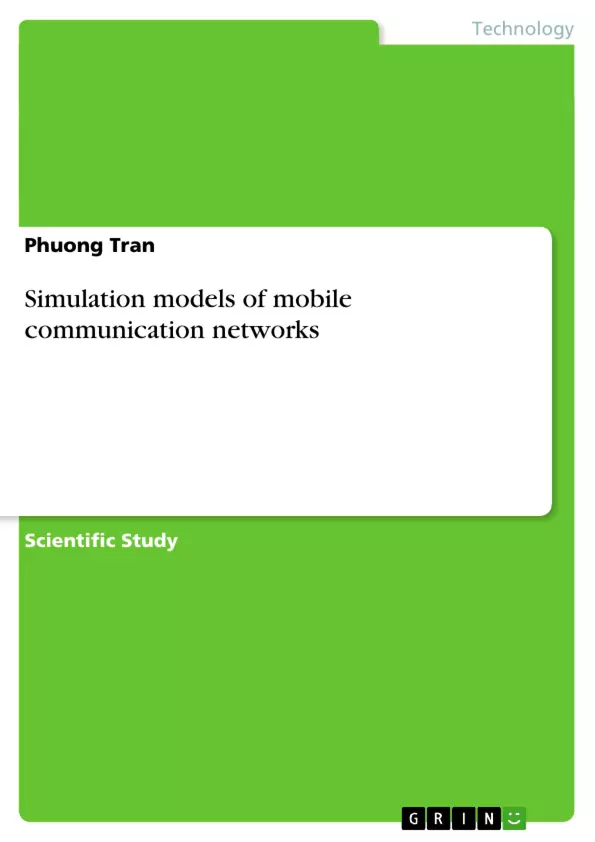This book is resulted from an electrical engineering research project at Ton Duc Thang University – Ho Chi Minh City in Vietnam. In this book, the authors introduce both fundamental theory and practical issues about mobile communication networks, including GSM networks, CDMA-based networks, MC-CDMA and MTC-MC-CDMA networks. Each issue is introduced together with simulation model written in MATLAB and/or SIMULINK. Most part of this book (chapters 2-5) can be used as a useful reference book for undergraduate students who are studying mobile communication, especially about simulation aspect. Other remaining parts is dedicated for graduate students, that is, some sections in chapter 4,5 and the whole chapter 6.
Inhaltsverzeichnis (Table of Contents)
- 1. INTRODUCTION
- 1.1 MOTIVATION
- 1.2 OBJECTIVES
- 1.3 METHODOLOGY
- 1.4 OUTLINE OF RESEARCH
- 1.5 OUTCOME OF PROJECT
- 2. INSTALLING AND USING
- 2.1 MAIN FEATURES OF SIMULATION PACKAGE
- 2.2 SYSTEM REQUIREMENTS
- 2.3 INSTALLING MATLAB
- 2.4 CONFIGURE THE VIETNAMESE LANGUAGE SUPPORT FOR
- 2.4.1 Reconfigure the Operationg System to support Vietnamese Keyboard
- 2.4.2 Install Vietnamese typing tool
- 2.5 USING SIMULATION TOOLS
- 3. SIMULATION OF GSM MOBILE SYSTEM
- 3.1 INTRODUCTION
- 3.2 PROPERTIES OF MOBILE CELLULAR SYSTEMS
- 3.2.1 Cellular Principles
- 3.2.2 Cell planning for mobile cellular networks
- 3.3 GSM ARCHITECTURE
- 3.4 CELL PLANNING FOR MOBILE CELLULAR NETWORKS
- 3.5 EQUALIZATION
- 3.6 SIMULATION OF TRANSMITTING AND RECEIVING PROCESSES IN GSM NETWORKS
- 3.6.1 System model
- 3.6.2 Simulation of Neural Network-based equalization
- 3.6.3 Flow charts of the simulation algorithm
- 3.6.4 Using the simulation program
- 4. CDMA NETWORK SIMULATION
- 5. SIMULATION OF MC-CDMA MOBILE COMMUNICATION SYSTEMS
- 5.1 INTRODUCTION TO MC-CDMA SYSTEM
- 5.1.1 MC-CDMA Transmitter
- 5.1.2 MC-CDMA Receiver
- 5.2 SIMULATION OF MC-CDMA TRANSMITTER AND RECEIVER
- 5.3 POWER CONTROL IN MC-CDMA NETWORKS
- 5.4 SIMULATION PROCEDURE FOR POWER CONTROL IN MC-CDMA
- 5.4.1 Parameters and Assumptions
- 5.4.2 Simulation Procedure
- 6. SIMULATION OF MULTICODE MC-CDMA SYSTEMS
- 6.1 INTRODUCTION
- 6.1.1 Multi-code CDMA System
- 6.1.2 Multi-code MC-CDMA System
- 6.1.3 Rate Adaptive Control for Multi-code MC-CDMA system
- 6.2 SIMULATION OF MTC-MC-CDMA TRANSMITTER AND RECEIVER
- 6.2.1 Simulation Program
- 6.2.2 Simulation Procedure
- 6.3 POWER CONTROL IN CDMA/FRMA NETWORKS
- 6.3.1 Introduction
- 6.4 SIMULATION OF POWER CONTROL IN CDMA
- 6.5 MS POSITIONING IN DS-CDMA MOBILE NETWORKS
- 6.5.1 Fundamentals of MS Positioning
- 6.5.2 Simulation Algorithm
- 6.5.3 Running Simulation with MobileSim
- 6.6 CONGESTION CONTROL IN CDMA/FRMA NETWORKS
- 6.6.1 Introduction
- 6.6.2 Simulation with MobileSim
- 6.7 SREADING CODE ALLOCATION ALGORITHMS FOR WCDMA NETWORKS
- 6.7.1 Introduction
- 6.7.2 Simulation program
- 6.7.3 Simulation Procedure
- 7. CONCLUSION
Zielsetzung und Themenschwerpunkte (Objectives and Key Themes)
This work aims to provide a comprehensive simulation of various mobile communication systems. The objectives include detailed modeling and analysis of different network technologies and their performance under various conditions.
- Performance analysis of GSM, CDMA, and MC-CDMA systems.
- Investigation of multiuser detection techniques in CDMA networks.
- Simulation of power control mechanisms in CDMA and MC-CDMA.
- Modeling of mobile station positioning in DS-CDMA.
- Congestion control in CDMA/FRMA networks.
Zusammenfassung der Kapitel (Chapter Summaries)
Chapter 1: Introduction This chapter introduces the motivation, objectives, methodology, and research outline for the project.
Chapter 2: Installing and Using This chapter details the main features of the simulation package, system requirements, installation of MATLAB, and configuration of Vietnamese language support.
Chapter 3: Simulation of GSM Mobile System This chapter covers the introduction, properties of mobile cellular systems (including cellular principles and cell planning), GSM architecture, cell planning, equalization, and the simulation of transmitting and receiving processes.
Chapter 4: CDMA Network Simulation This chapter focuses on generating spread spectrum code sequences, simulating direct sequence spread spectrum, frequency hopping spread spectrum, and multiuser detection methods (Decorrelation, MMSE, SIC, PIC).
Chapter 5: Simulation of MC-CDMA Mobile Communication Systems This chapter introduces MC-CDMA systems, describes the transmitter and receiver, simulates the system, and covers power control methods.
Chapter 6: Simulation of Multicode MC-CDMA Systems This chapter details the introduction to multicode MC-CDMA, its simulation procedure, and additional aspects such as rate adaptive control, power control, and mobile station positioning.
Schlüsselwörter (Keywords)
GSM, CDMA, MC-CDMA, Multiuser Detection, MMSE, Decorrelation, SIC, PIC, Power Control, Mobile Station Positioning, Congestion Control, Simulation, MATLAB, Vietnamese Language Support.
- Arbeit zitieren
- MEng Phuong Tran (Autor:in), 2007, Simulation models of mobile communication networks, München, GRIN Verlag, https://www.grin.com/document/124578



